Last updated on August 9th, 2024 at 09:53 am
Podcast: Play in new window | Download | Embed
Mario Gerard: Hello, and welcome to the TPM podcast with your host Mario Gerard. Today, we have a very special guest with us, Priyanka Shinde. She has extensive experience as a TPM. She’s worked as a TPM, a TPM manager, several organizations like cruise autonomous, Facebook and Meta. And she has over like 20 years of experience in the tech industry. She’s also launched TPMify, which is a coaching and consulting organization with a mission to help TPMs and TPM organizations reach their goals faster.
If you haven’t checked out our blog www.TPMify.com, that’s www.TPMify.com. You should definitely go check that out. It’s got a lot of interesting content. She’s been publishing a lot of great resources for TPMs. So do go and show some love. There aren’t many TPM bloggers and people are contributing back into the community. So, the few of us who are there, I would love for all of you to go and show some love and check out her blog and all the other workshops she’s trying to conduct.
Priyanka and I are today going to try to discuss the various types of product manager technical and TPM product type of roles. I’m sure you’ve seen a lot of these roles coming up in job boards recently. And so, we’re going to like try to decipher what the product manager technical role is and what the TPM product role is and how they kind of coexist.
Welcome Priyanka, Welcome to the TM podcast. Could you give our listeners a quick introduction of what you’ve done, where you’ve been and your journey so far?
Priyanka Shinde: Sure. Thank you, Mario, for having me on the podcast. It’s great to be here. Yeah, and thank you for the introduction. Like Mario said, I have over 20 years of experience in the software tech industry across, you know, various type of technologies, AI, machine learning, AP tech, education tech. And so, it’s been a really journey. I did start out as a software engineer and then transitioned to the TPM role because I really enjoyed kind of getting involved from like start to finish as well as just seeing kind of things come to life. And so that was my primary motivation of transitioning to TPM.
And then once I became a TPM, I worked at startups. I worked at, you know, like big companies, like Facebook as well as companies like Cruise. And I really enjoyed kind of like the different aspects of what was being offered by these companies. But throughout these times, I kind of became more and more passionate about the TM role. So, you’ll see me, that’s why I write a lot. That’s why I try to, you know, kind of really help back because I really feel very close to the TPM community. And I feel very passionate about building this strong TPM community because I truly feel that TPMS when leveraged correctly can make big impact on organizations. And I want TPMS to realize their own power, but I also want organizations to understand that that’s my aspirational goal for us TPMS.
What is TPM’s role and why does the industry need a TPM?
Mario Gerard: That’s so well put, and you could probably do an entire podcast with Priyanka’s journey of becoming a TPM because all of us have different journeys and different paths that we take it to get to where we are. So that’s kind of a real interesting journey to, you know, maybe decipher one day. But okay. Let’s start with, today’s like first question to Priyanka. Like Priyanka what do you think the TPM role is like decipher that in your own words, like what the TPM role is and why does the industry need a TPM?
Priyanka Shinde: Sure. Yeah. So, the TPM role or the technical program management role, I feel is a very special role in the sense that it has so much of that technical focus while leveraging your core program management skills and leadership skills. Sometimes I’d say, you know, TPMS drive holistic execution strategy by leveraging their deep domain expertise to basically meet the goals or deliver results, right? That’s the end goal.
And so, I feel like, you know, the industry has moved on from like program management or, I mean, we still have program managers, but the TPM role, I feel came more into prominence over the last maybe couple of decades because of the technological advancements that we are seeing in the products, right. Products are becoming more complex.
Now you have, you know, you don’t have kind of like single screen things or website it’s now, you know, like I can talk about autonomous [04:15 inaudible] all day long in terms of complexity, right? Yeah. And so, what that does is that you now, you know, you cannot just have coordination, facilitation, tasking, all of those are still important, but by having some of that technical expertise and domain knowledge, you actually elevate your program management skills. So that’s why I feel like the TPMs kind of is a role that has kind of evolved as well as gain more prominence in the last couple of decades.
What skills do you think TPMs require?
Mario Gerard: Yeah. I’ll add a little bit to that. Like the complexity of the programs have gone up so much and there’s so many teams that own separate confidence and do any complex program. All these teams need to get really well and interact so much that the need for somebody to step in, it could be a TPM. It could be an engineering manager, it could be anybody with different titles, but the role they’re trying to play is trying to bring these teams together to accomplish the final goal of the program. And that’s where you’ve seen the technical program manager role kind of blossom the last decade as Priyanka said. What are the skills do you think TPMs require?
Priyanka Shinde: Yeah, so of course, you know, we talk about technical, like the team TPM, largely, so you of course need the technical or the domain expertise. And that can be based on whatever background you have, or you can build on it, right. Or you can continue to like to evolve based on if you change domains. But besides the technical skills, you need strong program management skills, right. Something you just said, Mario, who is we have to be able to work with multiple teams. Like it’s a highly cross-functional role. And so being able to kind of have all of these balls up in the air, knowing which team to go to for what, and like managing all of this, the ability to see big picture and look around corners like, that to me, is very, very important in the TPM role.
Related read: Meta TPM Interview Guide
Besides that, I think TPMS need to have really strong communication, both written and verbal, right? We are to be working with a lot of different teams. We work all the way from our peers, other teams, that partner teams, as well as leadership and executives. And so, we need to be able to communicate exactly what we are seeing in a way that kind of brings confidence, but also provides clarity to our audience. And finally, like we need leadership skills, right? TPMS are there, they’re influencing without authority. We hear that, right. We are working again with multiple stakeholders. We have to build relationships. We have to motivate these teams. We have to manage the conflicts. Like there’s so much of all these people skills involved here. And it is a core part of this TPM role as well. So, I say those are the core things in terms of skills.
Communicating at different levels within the organization – What does a product manager do?
Mario Gerard: Yeah. Yeah. Definitely, communication is so important. Like we talk a lot about communication, but at the same time, unless you are a TPM and you’ve been in a role like that, you don’t understand the value of communication, how succinct you need to be sometimes. How you need to communicate at different levels within the organization, as you just mentioned, and the leadership skill, I think you called it a few, right? Like influencing with that authority is so important. Building relationships is so important. Motivating teams, as Priyanka said, super important when you don’t have a team reporting to you, especially, right.
This is completely like influencing without authority. And it’s so key, if you think about TPM skills. Let’s switch gears and move to the product manager role, because we’re going to be talking a lot about the TPM product and the product manager technical role. What does a product manager do and what is, his or her role?
Priyanka Shinde: Yeah. So, you know, sometimes there’s so many ways to define what the product manager role. And of course, we have a product manager here. They might say something. So, I’m going to kind of try and frame it the best I can without, I mean, I did kind of played a part product part program manager role at one point. But you know, of course in a lot of times when, even from a TPM perspective, we say, oh, product managers mainly define what, right? They are identifying significant opportunities. They’re driving product vision, strategies, roadmaps in the context of like the broader organizational strategy and goal.
They, of course, you know, in corporate data, research, market analysis to inform their product requirements and the priorities that they want to make. And of course, in all of this, you know, they’re defining requirements, they do this in collaboration, of course, with research, design, engineering TPM. And so, you know, sometimes even in small teams or startups product manager may do their own research, right. Or build their own wire frames or even like execute. This is where we start seeing overlap in responsibilities. But kind of that’s how I think about it is like PMs are defining the what in a nutshell, and then the TPMS do when and the how a little bit. So that’s kind of my take on the product manager responsibility.
What do you think are the skill sets, the PMs possess?
Mario Gerard: Yeah. We also, I think from a product perspective, they also probably do a little bit of the why, like what and why, right. It kind of goes hand in hand of doing like, why are we doing this, explaining especially to the dev team to tell them what the vision looks like, what is the vision and why do our customers care about this. Because we’re embarking on a mission of say spending like $10 million in developing costs and in infrastructure costs and what is the revenue rate of return, we can expect.
Addition to that, what do you think are the skill sets, the PMs possess? And then you’ll probably go into a little bit of the overlap between the two, but what skills do PM’s, product managers generally possess when they’re trying to be a product manager when they’re a product manager.
Priyanka Shinde: Yeah. Yeah. So, I think something you just said, right. Vision, like they need to have a vision and the ability to create a strategy to realize that vision, right. That is important. And that’s why like, telling, talking about the why and explaining it to other people is important. Some of the other things that I feel like product managers possess is an understanding of the market and the customer. Again, that is very important in terms of figuring out what vision is needed and what is the strategy to develop. They of course need solid prioritization rationale. Which, what do we do first versus what do we do next? And then we start getting into some of the things which can have overlap with TPM role, but like they also need to have strong communication skills. They need to be able to convince people to spend X amount of dollars to build a particular product. They need to be influenced; they need to be persuasive. But they also need to be very data driven and analytical.
Because you do need a lot of that. Like we know data informs like decisions. And so having that is critical. So, a lot of times I see product managers are very depth focused. They’re kind of taking one problem, one big problem and trying to kind of solve for that. So those are some of the things I feel like PMs should process.
How do PMs and TPMS collaborate?
Mario Gerard: It’s so interesting. As Priyanka is talking about the skills, there’s just tremendous amount of overlap of skills, of what a TPM kind of naturally possesses. Most TPMs naturally possess very good, we just spoke about what the TPMS role was and what the TPM skills are. And there’s, you can see that there’s definitely at least like a natural 30, 40% overlap maybe of similar types of skills and similar types of probably personalities as well to a large degree, right. Because a product managers kind of influencing up to his senior leadership of embarking on this mission. And then he’s also influencing below to the engineers that, hey, this is something we must do. And this is something that’s important to our customers. But at TPM is influencing a totally different perspective of, you know, getting things done.
So, it’s so interesting to see kind of the overlap between the product and TPM. As we’re talking about this Priyanka, like how do PMs and TPMS collaborate? They’re very boxed into the product manager role and there’s a TPM role in an organization. How do they collaborate? And do they even complement each other?
Priyanka Shinde: Yeah. So, let’s talk about that. You know, one of the things that kind of I just remembered is, one of the first companies I worked at, like the product manager role was very external facing. And then the program manager role was very much internal facing. So, kind of like how, where you’re taking the external, like market specifications and turning them into product requirements. And that is where a little bit of that boxing was done. And it was OK. It worked, right? But I think as again, like we talked about the evolution of both of these roles, the evolution of the products and the complexity around it. The product management role has also become a little bit more external as well as internal facing.
And this is where we kind of see this overlap in some of the skill sets as well as the responsibilities. So, one of the things that, you know, we used to stay at Facebook and we were trying, when we were trying to help everyone understand kind of how these roles complement each other and then how has they still different and still need it. So, the thing is to say is product managers lean towards vision and strategy and TPMs lean more towards execution and delivery.
And the key here is leads, which basically means that yes, we do more of that thing, that doesn’t necessarily mean we cannot do the other things if needed. This is where I feel like the overlap is there, but we also complement each other. Like these two roles I feel are very complimenting, right? Product managers sometimes are very forward looking. They’re thinking about that vision and what happens or how we can do this. They’re looking in the data and what is the next thing we need to develop? How do we grow this product?
But TPMs are saying, okay, I have this vision, I have the strategy. I have the priorities. I’m going to go and execute. I’m going to take care of the present and get things done. Doing both at the same time while possible in certain scenarios is not always effective. So, this is where I feel like PMs can, you know, work with TPMs to kind of execute on their vision. And then they can leverage the TPMS knowledge of like technical systems, and they can influence the requirements or the strategy to build like robust Futureproof products. But they can then really go and like go talk to the customers because that takes time, like go to your market research. So that’s how I think they can complement each other.
Mario Gerard: Yeah. And I feel that the role is definitely more of a marriage, right. It’s like a partnership role. If you work with PMs, sometimes there’s a little bit of love and hate because they want different things in life. But at the same time, they have to work together and they have to like complement each other. They are partners for the betterment of the organization, for the betterment of the feature set, for the betterment of the product itself. And so, it’s kind of very important partnership and you have to like, or love your counterpart and they are your counterpart. And they kind of, sometimes I also feel you fill gaps in their skill set and they kind of fill gaps in your skillset as well.
Because as you said, lean is a key word there. Leaning in and helping the other person out. And that person helping you out is a very, very close, collaborative partnership between the TPM and the product manager themselves. That’s a phenomenal way of looking at how these roles are almost coupled together.
Priyanka Shinde: It’s a coupling for sure. Like I was going to say that, you know, it’s the chemistry of a PM and a TPM. You never know how it comes around. And a lot of times, you know, TPMs are like, can we have like this R and R between these two functions and it’s very difficult. Like you can print out an R and R and you can stick it up on your desk, but the way to work with each other is to talk like, you know, sit down, talk, you know, what are your strengths? What are the gaps like you said, and then that’s where you can build that partnership? Cause sometimes you want to the same things also, right. Not just different, you want the same things. And that is when you start stepping on each other’s toes.
So, yeah, just talk to your PM or TPM counterpart. And figure out how best to work together.
Product Manager Technical Role – Why do organizations need this?
Mario Gerard: Yeah. I remember like having, I have this very close product managers who are still friends with, I worked with them like six, seven years ago and we used to have so much conflict, but then every day after that, we used to go for lunch and then beer in the evening. So that’s why I said it’s a little Love and hate is you might have disagreements because you want different things. But that disagreement is what brings you closer and what benefits everybody together. It’s a natural chemistry with the natural push and pull, which kind of finds its natural balance in an organization.
So that’s so well said there. And I also, I don’t know if you caught what Priyanka said, she was like, when we were defining the role at Facebook, it’s very interesting to talk to people like Priyanka, who’ve been through organizations, even large organizations who are identifying and recalibrating on what a particular role does.
And so, every organization goes through this and every, probably every decade, the role definition might move a little bit, might change a little bit as the industry evolves. And that’s why, the reason I’m bringing this up is the product manager technical role and the TPM product role is also a slight evolution of what was originally there and what the needs of the industry today are. And so, it’s kind of important to understand that you might not find so many product manager technical roles or so many TPM product roles. We talk a little bit more about this, but you’ll see them slowly, slowly, like the prominence of those roles are slowly increasing. And that is that our organizations are evolving, and the roles are also constantly evolving. So that’s something we keep in mind.
So, okay, Let’s on our next question. What is the reason for the evolution of the product manager technical role Priyanka and why do organizations even need this?
Priyanka Shinde: Yeah, so I think, I mean, we can talk a little bit about both, right? I think not all organizations need the product manager technical role, right. But many organizations need them because they’re working with highly technically complex products and systems. So again, you need product managers with that domain knowledge, that domain expertise, right. So, I’ve also seen where companies may not necessarily distinguish between a product manager and a product manager technical role, but they just look for that particular skill, If they are hiding for a product manager in a particular technical [18:10 inaudible].
Mario Gerard: A more technical product manager you mean, a more technical leaning. Okay.
Priyanka Shinde: Yes. So, they may not like differentiate by titles, but they might just look for that technical skill to put them in a more technically oriented role. But, you know, you can still call it a product manager technical role. And of course, you know, a lot of times what happens is there are many challenges that where your big teams, multiple teams, you have very complex products. It’s difficult for PM to be the TPM at the same time. And so, this is very, it’s helpful to have like a PM, product manager technical work alongside a TPM as well. And I do think like this role has gained a lot of prominence, especially in the past few years, like you were saying. What I think it does having those separate titles is it helps in distinguishing during hiring.
It becomes very clear during hiring that this is the skill it could require. It can also help certain people, you know, who kind of maybe come from a technical background and they really want to stay technical, but they want to kind of shift more into this product or TPM role. And so, it might help them look for those jobs that kind of satisfy their like technical curiosity a lot more. So, I feel like that’s why there is that differentiation in terms of title itself.
Product Manager vs Product Manager (Technical)
Mario Gerard: Yeah. That’s kind of interesting. That’s definitely interesting. How do you, like if you take a product manager, how does that differ from a product manager who’s technical? Like what would you say are like key, like two differentiators or three differentiators between the two roles?
Priyanka Shinde: I think like again, the focus for the product manager technical or technical product manager there is like, these terms [19:43 inaudible] is more technical, right? You need more domain specialization. So, for example, if you’re dealing with artificial intelligence, machine learning, there can be parts that are user facing. And then there can be parts that are more developing the algorithms, but some technical specifications in mind, or maybe you’re trying to develop the core AI platform, right. And that platform needs to be able to support the developers who are creating these AI algorithms.
So actually, at Facebook, I used to work for the Facebook assistant team and I used to work with both product managers and product managers who were more on the technical teams or kind of, we call, we kind of thought of it as the back end of the AI system. Even though the titles were not distinguished, their focuses were very different. And so, what that would have the PMTs or the technical product managers would then also work with the product managers who are more customer or user facing to also come up with the technical roadmap.
So now in case of a technical product managers, they have to come up with more of a technical roadmap and they have to think about the platform. They have to think about how the systems interconnect with other things. They need to know what is the product managers, customer focus roadmap is going to look like so that they can develop their underlying infrastructure in advance of that.
Mario Gerard: That’s so interesting that you see that within a team, which is kind of working together, you have both product managers and product manager technical folks. And they have different kind of responsibilities and they, or they own different platforms, or they have kind of either their one set is facing customers and then more focused on the front-end side. And there’s one focus completely on the back end, because the skills are kind of different. And it’s also interesting that you pointed out the distinguishing factors primarily helped during hiring.
And it’s also probably gives the manager who’s hiring a good insight to just think, what kind of skill am I even looking for. Because it’s not only from a candidate perspective that you should look at this, but you should also look at it from a manager who’s trying to grow his or her team. Like they’re trying to think like, who would be the best fit here? What are the kind of skills I kind of need for this person to solve the problems that we are going throw at them? So, it’s kind of interesting.
So, what are the companies that you’ve seen with the product manager technical role, which companies have you kind of encountered in that space?
Priyanka Shinde: Yeah, so of course, you know, at Cruise we definitely had like technical product managers. So, we had both like technical product managers, as well as consumer facing product managers. Like kind of, that’s how I call them. But I’ve seen this role particularly come up at Amazon, Intel, PayPal, Adobe, and a few different startups as well. I’m seeing more of these in the last few years, as opposed to maybe five years back. That is definitely telling something.
Mario Gerard: So, do you think these, when we talk about these companies, do you think they are hiring both technical product managers and they’re hiring also TPMS product also, right. So, it’s kind of, they’re doing both or they’re doing one or the other or?
Priyanka Shinde: Yeah. So, the TPM product role, that one is very much coming out of Facebook, at least kind of based on my context and association with that. And so yes, like Facebook obviously like has a lot, like it’s a huge company, right? There’s so many different teams. So, they have TPM product, they have PMs and then they have, sometimes they have these kind of underlying technical product manager roles that may or may not be distinguished by titles.
But for example, at Cruise, because I was there, I can tell you, like they hired both consumer PMs, which was like the traditional PM role, The product role. As well as technical product managers or PMT, sometimes technical product managers is also called PMT, just so that all the letters don’t end up being the same. But they’re then focused on defining, say the behavior of the car. They’re defining the requirements on how the car should behave in certain situations.
And they sometimes maybe informed by the user, which the other PM is telling them about. So yes, so they do hire both depends on what is the type of product you’re building.
What does Cruise do ?
Mario Gerard: Priyanka, why don’t you kind of give me like a, for people who don’t know a lot about crews, why don’t you give them like a two minute pitch of what does Cruise do for people who don’t know Cruise. If you don’t know, Cruise, you’re probably living under a rock, but then you should probably just tell our listeners, like what does Cruise do?
Yeah. So, Cruise is an autonomous driving company, right. They work on self-driving software. They are a company that is owned by GM. So of course, they are working very closely with GM in terms of developing the car. So more recently, like if you read the news, they got the permit to charge customers in San Francisco.
So, if you are in San Francisco, you can potentially hail a driverless car. And so, you’ll see these Cruise Chevy bolts along in San Francisco city if you’re ever here. But they’re primarily working on autonomous software. And the reality, like sometimes we see this it’s, it feels very science fictiony. But now it’s closed. Of course, Waymo is the other company That is been working on self-driving cars. And so, Cruise and Waymo, both doing really great and progressing ahead.
Mario Gerard: Yeah. And this comes back very interestingly, this comes back to the problem of solving complex problems, right? Like you need different types of people, different types of roles, however you define it. These are technical challenges that need to be solved either with the product hat, technically thinking how you solve these problems and with the execution hat, which is more of the TPM side.
And so, you see these companies which are trying to solve these never before solved problems, like Cruise trying to do this. And that’s why they kind of coming back to why we need this role. So, do you see a difference between the TPM that’s technical program manager product versus the product manager technical role?
Priyanka Shinde: Yes and no in some ways. The TPM product role is more of a TPM in product facing projects or consumer facing areas. So, for example, at Facebook ads or Instagram, for example, those are things that people use, right. There are interfaces or UI that people are using. And so TPMS in those spaces are more kind of product leaning. And so, they are the TPM product and they’re kind of leaning, They need to have a little bit more of the product sense.
Mario Gerard: And where do they use it? Can you give us an example of where they would use like a TPM? When they call TPM product, where would they use that product sense that you’re talking about? Like gimme a small example if you could.
Priyanka Shinde: Yeah, for sure. And again, like, I have always been what I would say a product TPM, because I’ve always worked in programs that have a product. I mean, that has a user or consumer focus. So, what happens is like when you are working on such kind of program that has an end user, right. It’s important to understand like the why, why is this, you know, what would the user do? How would the user react? Like it’s good to have because you build that customer empathy. And that also helps build your product sense.
Because when you are also talking to the product manager, right. We talked about it being a partnership. So, you don’t want just to take the requirements and move into execution. You want to understand the rationale behind the requirements. You want to, you know, sometimes you need to kind of demonstrate your product thought leadership in addition to your technical thought leadership.
And so, I would say that it’s important to understand part of why the product is being built, why it is important to build certain features now versus later. And that’s what I mean by having a little bit of that product sense, what kind of metrics or what is the success criteria for this product, right. That is the difference between say a purely said like opposite, that is an infrastructure program, right? So, we have sometimes [27:35 inaudible] TPMS that are focused on backend technical systems. And so, you’re kind of really your primary things might be capacity, latency, performance, all of this, Yes. Eventually they do impact whoever the end user is, but you’re thinking more in those terms as opposed to what a user sees or how the user interacts with the product itself. So that’s kind of the difference.
Mario Gerard: So TPM product, when you talk about customer facing metrics and KPIs and being more closer to the customer, do they actually define the metrics or are they like more, does the metrics, would you think the metrics are define the KPIs, the OKRs or whatever they are, right. Are they defined with a product manager, or would they be defined with TPM in this case?
Priyanka Shinde: I think it needs to be again a collaborative.
Mario Gerard: Both collaborating.
Priyanka Shinde: Yeah. Ideally that would be best, right? Because you’re both informing based on certain understanding or knowledge that you have, right. The PM comes with the market knowledge, the research that has been done. The TPM comes with, you know, understanding of the technical systems and things like that. And so, then they can both work together and say, yes, this is what the metrics might look like. And some of those metrics are very much user facing and some of those can be a little bit more technical, right? So, say for example, performance. Like performance, If the site is slow to load it’s both technical metrics, but for the user, all that it means is that they’re waiting X number of seconds. I’m giving you like a simple example. That is what I mean.
Why The ‘TPM Product Manager’ Role Is Gaining Prominence?
Mario Gerard: That makes so much sense. That makes so much sense. We did talk little bit about that the role is gaining prominence that both these technical product manager roles and the TPM product manager roles gaining prominence, why do you think it’s gaining that kind of a prominence?
Priyanka Shinde: Yes. I think let we talk a little bit about the TPM product role first, and then we’ll also jump into PMT because this is something we talked about a little bit earlier, right? So, on the TPM product side, that role, I think gained prominence and I was there at Facebook in the early days when this role was evolving and some of it was again, TPM product is basically another type of TPM product, but it has been distinguished so that we can kind of hire properly. We can distinguish those skills and it also helps people understand what they will be working on.
So that’s kind of why the distinction is made. Similar to the PMT role, the product manager technical role, where you might want to hire somebody with a more technical background or expertise. And so, we talked about like, you know, what are the difference between those two roles and so while PMTs work in more, they need a more of a technical sense. You know, how I talked about TPM product needs more product sense. The PMT needs more technical sense. And that’s where kind of, they are complimenting each other in different areas with their counterparts as well.
Sometimes you can have both on the same team. And that usually helps with managing the size, the breadth, the complexity, balancing, like building a future roadmap versus like the current roadmap needs to be delivered.
PMT & TPM – The overlap?
Mario Gerard: And you think that there’s like an overlap of responsibilities. We did talk about overlap between product and TPM generally. But between the PMT and the TPM, do you think there’s a lot of overlap?
Priyanka Shinde: I think there is. So, in some, you know, in some cases or earlier in highly like these technical areas, the TPM used to kind of play the PMT role that we see today. I think they can both to a certain extent, like define the requirements, work in collaboration with other teams, but in smaller teams, like the PM might just do the research or kind of like even to execute a little bit. They both have understanding of the, or system architecture or the constraints that the technical constraints that might want to fix. They both can do the execution and deliver in certain cases.
So, I think yes, like, but again, when you have both of them, the time to bring, have both PMT and a TPM on a team is when the product is highly complex. It is like the breadth of the program is huge. You are maybe dealing with 5, 10 teams, you have to go talk to X number of people you have to deliver on this roadmap. So, there’s a lot happening and it’s too much for one person to do it effectively. That’s when you would have both on the team.
But can one person do the other things? Yes. On smaller teams, like if you have, you know, the small product, maybe 10 people that you’re working with, you could potentially do both.
‘Product Manager Technical’ Skills
Mario Gerard: That makes a lot of sense, like the scope of the program and how many people or how many teams it is touching is really important when you kind of design your team with these different types of roles. Let’s move on to the next question, like from a skill perspective, tell us what are skillsets a PMT should have. And then we’ll probably go to the skillset for a TPM, right. And connecting the two. But a PMT, a product manager technical, what are the kind of skill they need to have?
Priyanka Shinde: Yeah. So, the PMTs similar to like your product manager role, right? A lot of the skill sets are similar, right. They need to be able to identify these significant opportunities, develop the product vision, the strategy, go talk to the broader organization. A lot of times now you are going and talking in terms of more technical product, you’re using more of that technical system knowledge with those conversations. Of course, you know, the skillset, the additional skillset that is needed, I would say is that technical depth and expertise.
But you also, you know, of course, you know, there might be incorporating the data, the research, but it’s maybe in a different form, right. Maybe it’s more from a system performance perspective rather than like getting a user, you know, how many clicks they’re doing or things like that. So, I would say that’s the skillset that a PMT needs. Yeah. And then we can also like move on to the TPM role. We obviously talked about like some of the TPM skills, but what the TPM can do really is when the scope is huge, like they can connect the dots.
They’re talking to a lot of different people while they’re kind of trying to execute on the program so they can see the big picture. They need to understand the technical constraints. They need to be able to manage risks, mitigate risks, and manage the dependence. Cause I think that is a very critical aspect of the TPM role.
Mario Gerard: And at that scale, right? And when you’re talking to like 20 or 30 or 50 teams, that becomes a pretty big piece of what the TPM does.
Priyanka Shinde: Definitely. I think risk management and managing the dependencies is really, really critical to the role. I mean, even if you have like five teams, but yes, like it exponentially becomes harder when you have more and more people involved. So, I think, yeah, I mean the TPM can sometimes kind of go broad, right? Because you can deal with more people which helps manage these big problems. Whereas PMTs have to kind of stay focused on the problem set that they’re trying to solve the vision they’re trying to create. But they can take support of the TPM to kind of, you know, manage all of these different, different stakeholders in order to deliver the product.
Mario Gerard: Cool. Do you think between the product manager, technical and the TPM, if there’s one person, can they switch like back and forth between these two roles? Not immediately, but from a career perspective, would you think that, you know, we spoke a little bit of the skills, they all seem to a little, have a little overlap. So, do you think like I’m thinking whether they can switch between roles? Like can I be at TPM today and like six months later say, hey, I’m going to go and try this product manager technical role out for some time.
Priyanka Shinde: Yes, I think so. I mean, there are so many overlaps in responsibilities and then skill sets that definitely, I think shifting between these two roles is easy, at least for personnel. I think why, or when you should do it is dependent on, you know, kind of what are the things you enjoy doing more? Do you enjoy, you know, kind of like creating that vision strategy roadmap, or sometimes you try want just execution and delivery is your thing. So, depending on what you enjoy doing, you can kind of pick one, but yes, I think you can easily change and kind of switch back [35:11 inaudible].
Importance of figuring out what you want to do?
Mario Gerard: That’s so interesting. Like I want to double down on what Priyanka just said, that when you are choosing roles, whether you’re an engineer trying to become a TPM or an engineer trying to become a dev manager or a dev manager becoming a TPM, a TPM becoming a dev manager, all of these roles, people move between these roles a lot. And I think what Priyanka said is so important is that you need to figure out like what your skillset is and what you want to do and what you’re good at, right? Like it’s so important to figure that bit out. And then the role becomes easier.
Because if you are doing vision, then maybe you want to go more towards the product manager technical route, where you still have the technical chops, but you’re more interested in the vision and talking to the customers and those kind of things. But if you want to be more on the execution side and that’s your thing, then you go on the TPM side. I think I have one last question for you Priyanka, the product manager technical role. Do you know where it came from? And what’s the history behind that? I think we spoke a little bit about this earlier, but I think when we were talking about it, you were talking about meta previously and you were saying you could share some context of where this role originated from.
Priyanka Shinde: Yeah. So, I think that mostly I’ve seen the TPM product role at Facebook or Meta. And so, when I joined Facebook in 2016, again, I was kind of part of this product TPM organization. It was kind of, it’s [36:42 inaudible] stages at that time. It was ads. And then we had business platform, which was, you know, a different team. And so, I think maybe there were around 20 TPMs there. And of course, you know, the [36:52 inaudible] TPM organization within Facebook had existed for a much longer time. Because that is where the TPM organization or the hiring started, which is understandably so.
So, I think what we experienced is how do we want attract the TPMS into our teams? How do we make sure that we are hiring with the right skillset? And then how do people know that what they will be working on or what is the type of things that they will be doing, right.
Cause when you only see one type of a role or then, then that is kind of what becomes much more widely known. And so, the product TPM role was an effort to basically help distinguish for hiring purposes, understanding the skill sets we need. Like I was mentioning a little bit of product sense that you need, right? So, during interviewing for the product TPM role, the questions that we would ask would have a little bit of that, you know, gauging of, does this person understand why we develop these metrics? Or is there like, you know, that little product sense, you know, understanding of the customer, do they have that?
And so, while they may not a sit and write requirements, It was just that understanding that helps them become a better TPM when they’re working on the product side. So that is some of the history.
And so, there was a set of TPMs myself and a few other TPMs. We worked on kind of evangelizing that role a little bit, set up the interviewing framework as well as I think there was some external articles or publishing that was done, just an effort to help people. Because also what happens in this situation is there’s sometimes already a product manager, right?
Most of these teams already had a product manager from the beginning. So now it was also important to distinguish how this TPM role, the product TPM role and the product manager role is still both are still needed. And they’re not really kind of encroaching on each other’s space. So, there was also an effort to make sure that we kind of distinguish the product manager versus the product TPM role as well. And this is where, you know, that whole statement about leaning more towards vision strategy versus leaning more towards execution delivery came from. So that’s the context on product TPM at Meta.
Mario Gerard: That’s like so interesting. You hear the history and the context of how these roles evolve, because it also gives you a sense of what the vision of creating this was, right. What does the team think that was missing or possibly missing and what are they trying to address? And so, it’s like, it’s really interesting to hear these stories from people like Priyanka who’ve been there, who were in the weeds while this whole movement was coming along. So, it’s like very nice to hear that from Priyanka.
Thank you so much Priyanka for sharing all your thoughts on the product manager, technical and TPM product roles. It was really, really insightful.
Priyanka Shinde: Add one thing. Something you mention earlier, right. Switching between PMT and TPM roles, even switching between a product TPM and a product manager role. I think that is also something that people do often. So, you know, that is also that option because if you are a product TPM and you realize, okay, down the line, you really just love kind of developing that vision and strategy. Then the product manager role is also something you can totally do.
And so, we talked a lot about like, what are you good at? What do you enjoy doing? Because after all those are our strengths, right? And so like, if we lean into our strengths, I think the work becomes much more enjoyable.
Mario Gerard: Yeah. And easier, easier and enjoy. Absolutely. Thank you so much for, you know, doing this with me today. I’m hoping to have Priyanka more and you know, have more conversations with her and do some podcasts. But definitely check out her website. She’s publishing a lot of very, very interesting, very insightful content for technical program managers. And she’s also offering like resume workshops and career management sessions. So, there’s a lot you’re going see from Priyanka. So definitely check her out and it’s going to be fun.
And I invite more people to come and blog and share the experience on the technical program management domain. Sometimes I feel that there isn’t enough being done. You see have a lot of people on the product side, I think the product people are, you know, they’re so evangelistic about their role. And there isn’t, you know enough said about the TPM role. And there are equal number of TPMS product managers receive most organizations. So definitely encourage more of you to write on LinkedIn or write in other mediums and then definitely encourage the people who are newly coming to write and contribute back to the community. Thank you so much again Priyanka, thank you for being here with us today and hope to see more of you.
Priyanka Shinde: Yeah. Thank you, Mario. It was great chatting with you, and I have to also thank you for kind of spreading the love on the TPM community and doing everything that you do. I mean, Mario has been great, you know, the courses you have and everything. So, it’s great for like aspiring TPMs. So yeah, like Mario said, we need more of these. We need to kind of rally around our community. So, you know, kind of please do so. And we’ll be here. I mean, we’ll be rooting for you.
Mario Gerard: Take care folks. See you on the other side.

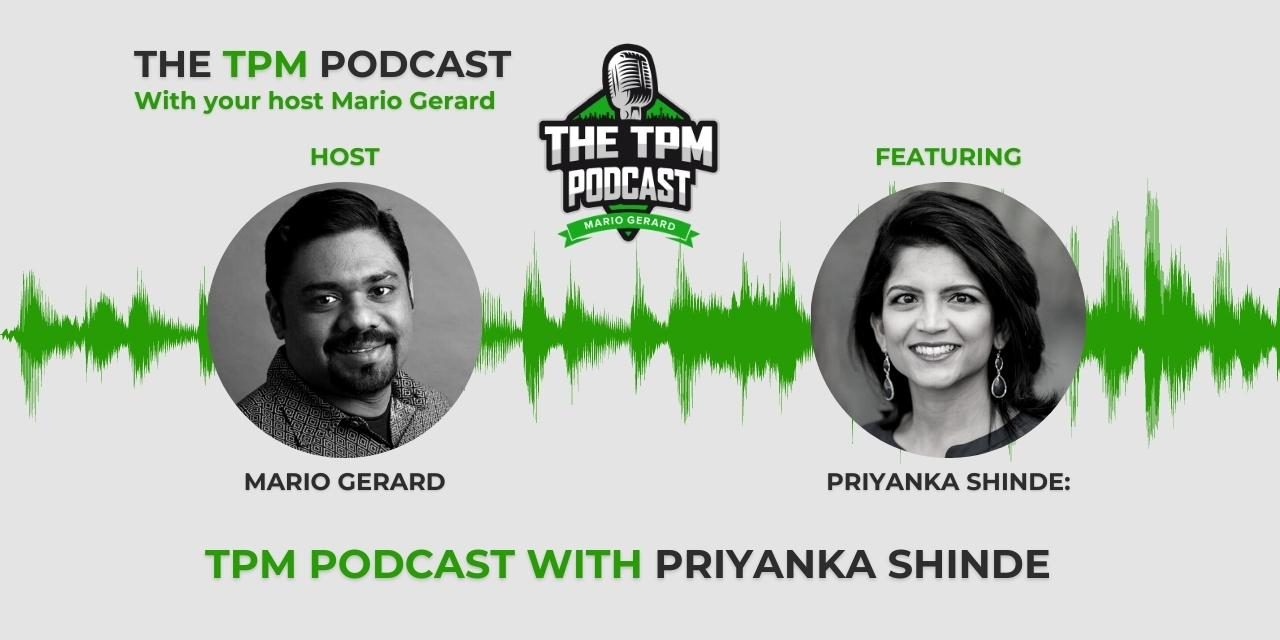
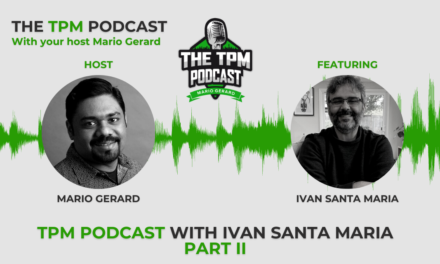
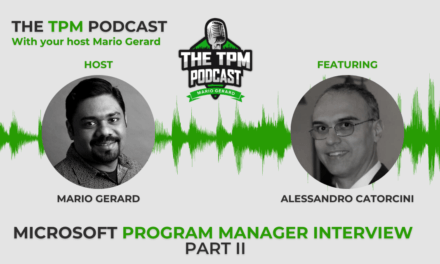
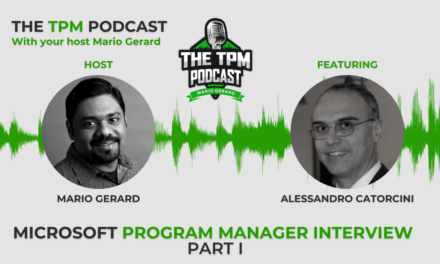
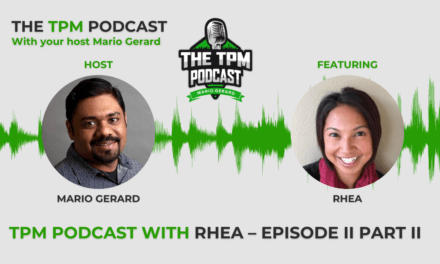





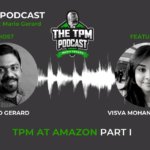

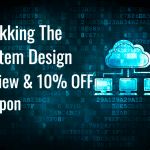




A great Podcast for sure! I believe one very important thing we missed here. Technical Anchor vs Technical Program Manager. It might be possible that Tech Companies like Google, Meta or Amazon have not seen this Challenge but in OEMs like Ford , Introduction of Tech Anchor role from past 4-5 years has completely eliminated the need of TPMs. Because Tech Anchors are trying to own the execution and delivery. I like to hear your thoughts on it, Now they are again introducing TPM roles adapting from Tech Companies, but the Journey is slow and it needs a change in mindset.
This was really insightful, especially for a person who is contemplating to transition to a TPM role from product management. Thanks Mario and Priyanka for doing this.